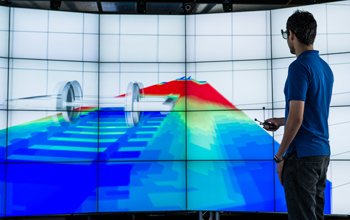Multimedia Gallery
Standing inside virtual train tracks in the CAVE2 system
A researcher at the Electronic Visualization Laboratory stands inside virtual train tracks in the CAVE2 system to observe distortion as high-speed trains roar past.
More about this image
This visualization of fundamental dynamics phenomena related to high-speed rail operations was done in collaboration with the National University Rail (NURail) Center. NURail is a consortium consisting of researchers at the University of Illinois at Urbana-Champaign, UIC, the Massachusetts Institute of Technology, Michigan Tech University, the University of Kentucky, the University of Tennessee, Knoxville, and the Rose-Hulman Institute of Technology, and is funded by the U.S. Department of Transportation. Understanding track structure movements, liquid sloshing and wheel/rail contact locations are among several transportation research areas that require sophisticated virtual reality tools like the CAVE2 system. EVL OmegaLib software was used to display the 3-D model in the CAVE2 system.
This research is supported by a National Science Foundation Major Research Instrumentation grant under the American Recovery and Reinvestment Act of 2009. The award, "MRI-R2: Development of the Next-generation CAVE Virtual Environment (NG-CAVE)" (grant CNS 09-59053), is under the direction of Andrew E. Johnson, Jason Leigh, Maxine D. Brown and Tom Peterka, May 2010 to April 2013.
You can learn more about research in the CAVE2 system in NSF press release 12-228, State-of-the-Art Virtual Reality System Is Key to Medical Discovery. Or visit the EVL website Here. (Date of Image: 2012)
Credit: Photo by Lance Long; courtesy Electronic Visualization Laboratory, University of Illinois at Chicago
See other images like this on your iPhone or iPad download NSF Science Zone on the Apple App Store.
Images and other media in the National Science Foundation Multimedia Gallery are available for use in print and electronic material by NSF employees, members of the media, university staff, teachers and the general public. All media in the gallery are intended for personal, educational and nonprofit/non-commercial use only.
Images credited to the National Science Foundation, a federal agency, are in the public domain. The images were created by employees of the United States Government as part of their official duties or prepared by contractors as "works for hire" for NSF. You may freely use NSF-credited images and, at your discretion, credit NSF with a "Courtesy: National Science Foundation" notation.
Additional information about general usage can be found in Conditions.
Also Available:
Download the high-resolution JPG version of the image. (3.7 MB)
Use your mouse to right-click (Mac users may need to Ctrl-click) the link above and choose the option that will save the file or target to your computer.



 All images in this series
All images in this series